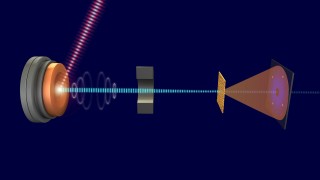Aug 6 2015
A new scientific instrument at the Department of Energy’s SLAC National Accelerator Laboratory promises to capture some of nature’s speediest processes.
 Illustration of SLAC’s new apparatus for ultrafast electron diffraction – one of the world’s fastest "electron cameras" for some of the speediest motions in materials. Credit: SLAC National Accelerator Laboratory
Illustration of SLAC’s new apparatus for ultrafast electron diffraction – one of the world’s fastest "electron cameras" for some of the speediest motions in materials. Credit: SLAC National Accelerator Laboratory
It uses a method known as ultrafast electron diffraction (UED) and can reveal motions of electrons and atomic nuclei within molecules that take place in less than a tenth of a trillionth of a second – information that will benefit groundbreaking research in materials science, chemistry and biology.
“We’ve built one of the world’s best UED systems to create new research opportunities in ultrafast science,” says SLAC’s Xijie Wang, who is in charge of developing the new instrument described in a paper published July 24 in Review of Scientific Instruments. “Our apparatus delivers electron beams with a better quality than any other UED machine. For example, it allows us to study chemical processes in the gas phase that are up to four times faster than those we can examine with current UED technologies.”
The technique complements ultrafast studies with SLAC’s X-ray free-electron laser. Similar to X-ray light, highly energetic electrons can take snapshots of the interior of materials as they pass through them. Yet, electrons interact differently with materials and “see” different things. Both methods combined draw a more complete picture that will help researchers better understand and possibly control important ultrafast processes in complex systems ranging from magnetic data storage devices to chemical reactions.
‘Seeing’ Ultrafast Processes with Electrons
The superior performance of the new UED system is due to a very stable “electron gun” originally developed for SLAC’s X-ray laser Linac Coherent Light Source (LCLS), a DOE Office of Science User Facility. This electron source produces highly energetic electrons, packed into extremely short bunches. It spits out 120 of these bunches every second, generating a powerful electron beam that the researchers use to probe objects on the inside.
But how can scientists actually catch a glimpse of the interior of materials with particles like electrons?
The method works because particles have a second nature: They also behave like waves. When electron waves pass through a sample, they scatter off the sample’s atomic nuclei and electrons. The scattered waves then combine to form a so-called diffraction pattern picked up by a detector. The whole apparatus works like a high-speed camera, capturing differences in diffraction patterns over time that scientists use to reconstruct the sample’s inner structure and how it changes.
Since electron bunches in SLAC’s UED instrument are extremely short, they reveal changes that occur in less than 100 quadrillionths of a second, or 100 femtoseconds, for instance in response to ultrashort laser pulses.
“UED has been under development for the past 10 to 15 years, but the repulsive forces between electrons in the electron beam limited the time resolution of previous experiments,” says the paper’s first author Stephen Weathersby, the facility manager of SLAC’s Accelerator Structure Test Area (ASTA), where the UED machine is installed. “LCLS expertise in electron gun technology and ultrafast laser systems gives our system the performance and stability needed to study much faster processes.”
Electrons Plus X-rays for Ultrafast Science
Electrons behave similarly to X-rays in the way they explore speedy phenomena in nature. Electrons scatter off both electrons and atomic nuclei in materials. X-rays, on the other hand, interact only with electrons. Therefore, electron and X-ray studies of very fast structural changes complement each other.
The SLAC-led team has already begun to combine both approaches to better understand the link between the magnetic behavior of certain materials and their structural properties in studies that could help develop next-generation data storage devices.
Electrons also provide a path to studies that are very challenging to perform with X-rays.
“Electrons interact with materials much more strongly than X-rays do,” says SLAC’s Renkai Li, the paper’s lead author. “We were able to analyze samples such as very thin films whose X-ray signals would be very weak.”
For instance, the researchers studied a single atomic layer of a material that is interesting for future electronic devices.
“Another interesting case is gas phase samples,” Li says. “Due to the almost 1,000-fold shorter wavelength of electrons compared to X-rays, UED can see much finer structural details. We’re able to see how atoms in molecules move with UED, which is an important step toward making molecular movies of ultrafast chemical reactions.”
Adding ‘Ultrasmall’ to the Mix
The researchers have already mapped out the next steps to further improve the UED instrument.
They plan on making it even faster – corresponding to a camera with a shutter speed close to 10 femtoseconds – and will eventually reduce the size of the electron beam from its current 100 microns – the diameter of an average human hair – to below one micron. These advances could be used to investigate how ultrafast motions in tiny regions of materials are linked to magnetism and other material properties.
The scientists’ ultimate goal is to turn UED into an ultrafast electron microscope – an instrument that would show details too small to be seen with an optical microscope. Existing electron microscopes can already capture events in 10 billionths of a second, but with SLAC’s instrument, the researchers hope to push the speed limit to processes that are 1,000 times faster.
“Ultrafast electron microscopy will bring two established, independent communities together: researchers working in electron microscopy and in ultrafast X-ray science,” says co-author Hermann Dürr of SLAC, who is one of the project’s science coordinators. “This will generate unforeseen possibilities for ultrafast science with electrons, similar to the great things we saw happening a few years ago at LCLS, when laser science and X-ray science merged into the new field of ultrafast X-ray science.”